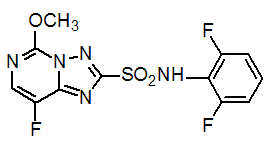FLORASULAM 双氟磺草胺
Introduction: A herbicide used for post-emergence control of broad-leaved weeds in wheat, barley, oats, rye and triticale field.
Common name: Florasulam
Another name: Kantor, Primus, etc.
Chemical name: 2',6',8-trifluoro-5-methoxy[1,2,4]triazolo[1,5-c]pyrimidine-2-sulfonanilide
Empirical formula: C12H8F3N5O3S
Structural formula:

Mol. Weight: 359.28 g/mol
CAS No.: 145701-23-1
Specifications
Leading Florasulam supplier
Florasulam 50 g/L SC
Florasulam 95% TC
Packing:
BULK PACKING
Solid: 25kg/Bag, 25kg/Drum, 50kg/Drum etc.
Liquid: 200L/Drum, 20L/Drum, 10L/Drum ect.
SMALL PACKING
Solid: 1kg/Alu bag, 500g/Alu bag, 200g/Alu bag, 100g/Alu bag, 50g/Alu bag, 15g/Alu bag etc.
Liquid: 5L/Drum, 1L/Bottle, 500ml/Bottle, 250ml/Bottle, 100ml/Bottle, 50ml/Bottle etc.
Customerized packing label
Professional registration
HAZARDS IDENTIFICATION
Hazard statement(s)
H400: Very toxic to aquatic life.
H410: Very toxic to aquatic life with long lasting effects.
Precautionary statement(s)
P273: Avoid release to the environment.
P391: Collect spillage.
P501: Dispose of contents/container to ...
Supplemental Hazard Statements: none
MAMMALIAN TOXICOLOGY
Acute toxicity: 1) Acute oral LD50 for rat: 5000 a.i.mg/kg. 2) Acute dermal LD50 for rat: >2000 a.i.mg/kg. 3) Inhalation LC50 (4 h) for rat: >5.0 a.i. mg/L. 4) Non-irritating to skin (50 g/L SC, rabbits). 5) Minimally irritating to eyes (50 g/L SC, rabbits). 6) Non-sensitising to skin (50 g/L SC, guinea pigs).
NOEL: (90 d) for rats and mice is 100 mg/kg b.w. daily. Negative in genotoxicity and Ames tests.
ADI: 0.05 mg/kg b.w./day
Classification:
Toxicity class WHO (a.i.): U (Unlikely to present an acute hazard)
EC Risk Classification: N - Dangerous for the environment: R50, R53
ECOTOXICOLOGY
Effect on birds: moderate toxicity to birds, acute oral LD50 for Japanese quail is 1046 a.i.mg/kg. Effect on fish: low toxicity to fish, acute 96 hour LC50 for Rainbow trout is >100 a.i.mg/L. Effect on aquatic invertebrates: low toxicity to aquatic invertebrates, acute 48 hour EC50 for Daphnia magna is >292 a.i.mg/L. Effect on algae: high toxicity to algae, acute 72 hour EC50 is 0.00894 a.i.mg/L. Effect on honeybees: low toxicity to honeybees, contact acute 48 hour LD50 is >100 a.i.μg/bee, oral acute 48 hour LD50 is >100 a.i.μg/bee. Effect on earthworms: low toxicity to earthworms, acute 14 day LC50 is >1320 a.i.mg/kg.
ENVIRONMENTAL FATE
Florasulam's production may result in its release to the environment through various waste streams; its use as a herbicide will result in its direct release to the environment. If released to air, a vapor pressure of 7.5×10-8 mm Hg at 25 deg C indicates florasulam will exist in both the vapor and particulate phases in the atmosphere. Vapor-phase florasulam will be degraded in the atmosphere by reaction with photochemically-produced hydroxyl radicals; the half-life for this reaction in air is estimated to be 20 hours. Particulate-phase florasulam will be removed from the atmosphere by wet or dry deposition. Florasulam does not absorb light at wavelengths >300 nm, therefore it is not expected to be susceptible to direct photolysis by sunlight. If released to soil, florasulam is expected to have moderate mobility based upon an estimated Koc of 160. The pKa of florasulam is 4.54, indicating that this compound will exist partially in the anion form in the environment and anions generally do not adsorb more strongly to soils containing organic carbon and clay than their neutral counterparts. Volatilization from moist soil surfaces is not expected to be an important fate process based upon an estimated Henry's Law constant of 5.7×10-12 atm-cu m/mole. Florasulam may not volatilize from dry soil surfaces based upon its vapor pressure. Based on experiments using moist and dry soil exposed to light and dark the estimated photodegradation half-life in summer at 40 deg N latitude was 14 days on soil. An average biodegradation half-life of 2.4 days with ultimate mineralization to CO2 and non-extractable residues indicates that biodegradation may be an important environmental fate process in soil and water. If released into water, florasulam is not expected to adsorb to suspended solids and sediment based upon the estimated Koc. Volatilization of the neutral species from water surfaces is not expected to be an important fate process based upon this compound's estimated Henry's Law constant. The pKa indicates florasulam will exist partially in the anion form at pH values of 5 to 9 and therefore volatilization from water surfaces is not expected to be an important fate process. An estimated BCF of 3 suggests the potential for bioconcentration in aquatic organisms is low. Hydrolysis is not expected to be an important environmental fate process since this compound lacks functional groups that hydrolyze under environmental conditions. The measured photodegradation half-life in water at 51.5 deg N was 3.3 days. Occupational exposure to florasulam may occur through inhalation and dermal contact with this compound at workplaces where florasulam is produced or used. (SRC)
Usage: Reported by A. R. Thompson et al. (Proc. Br. Crop Prot. Conf. - Weeds, 1999, 1, 73); see also papers in Proc. 9th IUPAC Int. Congr. Pestic. Chem., London, 1998, 2. Discovered by Dow AgroSciences, and introduced in Belgium in 1999. Manufacturers: Dow AgroSciences. Branched chain amino acid (leucine, isoleucine and valine) synthesis (ALS or AHAS) inhibitor. Selectivity in wheat is due to differential metabolism.
Application: Taken up by root and shoots, and translocated in both xylem and phloem. Herbicide for post-emergence control of broad-leaved weeds, especially Galium aparine, Stellaria media, Polygonum convolvulus, Matricaria spp., and various cruciferae, in cereals and maize, at rates up to 7.5 g/ha.
| 






